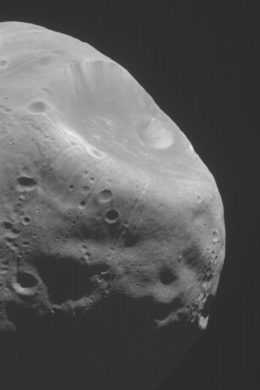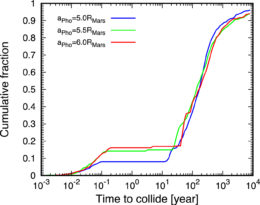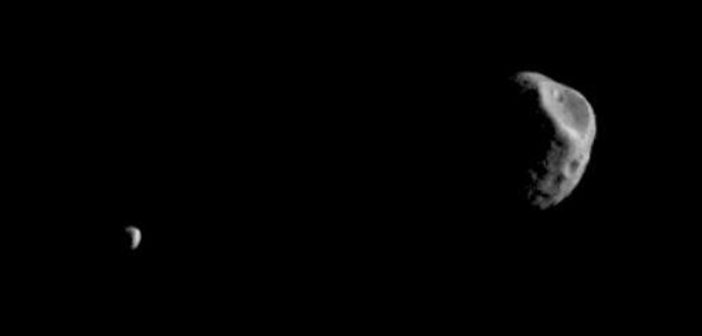Were Mars’s two moons once asteroids? Did they coalesce from the debris created when a massive object struck Mars? Or, as explored in a recent article, did they form when a single moon split in two?

A close-up view of the larger of Mars’s moons, Phobos, taken by the Mars Global Surveyor spacecraft. [NASA/JPL/Malin Space Science Systems]
Martian Moon Mysteries
Mars’s two small moons, Phobos and Deimos, are of unknown origin. Researchers have attempted to interpret the clues left by the moons’ shapes, sizes, colors, and orbits, but the trail has been difficult to trace. For instance, while the moons’ reddish surfaces hint that they might be captured asteroids, their nearly circular orbits suggest they formed near their current locations instead. With evidence to support several hypotheses, scientists have long debated the merits of competing formation pathways.
Recently, a new hypothesis has arisen: Mars once possessed a single moon that was cracked in two by a massive collision, resulting in a pair of smaller moons that became Phobos and Deimos. In a new publication, Ryuki Hyodo (Institute of Space and Aeronautical Science/Japan Aerospace Exploration Agency) and collaborators have used state-of-the-art simulations to put this theory to the test.

Simulation results showing the collision times for the two moons. The line colors indicate the results for different initial values of Phobos’s apoapsis (aPho) — the greatest distance from Mars’s surface reached during an orbit. [Hyodo et al. 2022]
N-body Insights
Hyodo and collaborators performed N-body simulations to investigate how the orbits of the two young moons that formed in the theorized collision would have changed over time. If the simulations show that the moons migrate into orbits similar to those of Phobos and Deimos today, that would lend credence to the idea that Mars’s moons formed from a single moon that existed in the past. If instead the simulations generate dissimilar orbits — or predict that the two new moons collide with each other — that would suggest that this origin is unlikely.
The team simulated the movements of the new moons as their orbits evolved in the 10,000 years after the collision that created them. Using predictions from previous studies as a starting point, the team conducted 1,800 simulations in which the initial orbits of the two moons varied slightly. In more than 90% of simulations, the two moons collide within 10,000 years, with a substantial number of collisions happening within just a few days. This already disfavors a single-moon-split-in-two origin for Phobos and Deimos — but what happens after the two new moons collide?
Rings Reconstructed

Mass of Phobos (red), Deimos (blue), and the debris ring (black) after the moons collide, shown as a function of the impact velocity. The dashed red and blue lines show the initial masses of Phobos and Deimos, respectively. [Hyodo et al. 2022]
This study found that the collision scenario is an unlikely origin for Mars’s moons, though more modeling is needed to incorporate additional factors and test the theory further. For now, the mystery of Mars’s moons continues!
Citation
“Challenges in Forming Phobos and Deimos Directly from a Splitting of an Ancestral Single Moon,” Ryuki Hyodo et al 2022 Planet. Sci. J. 3 204. doi:10.3847/PSJ/ac88d2
